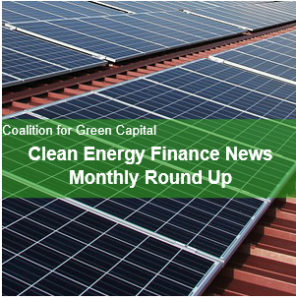The Clean Energy Future Blog
Clean Energy Finance News – Monthly Roundup
By Coalition for Green Capital

This is the October installment of the CGC’s monthly news roundup, where we compile important news and commentary on public and private investment in clean energy projects. We’ve searched the internet to find the news stories that will keep you up to speed and informed on blended finance approaches to clean energy.
Connecticut Green Bank receives DOE Grant for Improving Solar Access for Low- and Moderate-Income Communities
“The federal government is supporting a clean energy public-private partnership which makes renewable energy more readily available to those who need it most. PosiGen is proud to announce that its solar partner, Connecticut Green Bank, will receive funding through the U.S. Department of Energy SunShot program to expand its efforts to make solar power more accessible.”
AIIB Opens First Consultation for Landmark Energy Strategy
“The Asian Infrastructure Investment Bank last week launched the initial stage of public consultations for its first energy strategy — a crucial piece of policy that will play a significant role in the Beijing-based institution’s pursuit of becoming a “green bank. President Jin Liqun has repeatedly said that AIIB will be a “lean, clean and green” institution focusing simultaneously on growth, development and the environment. This includes a focus on what kind of projects, particularly on energy, the bank should and will finance.”
Green Bank Network Announces $22 Billion Milestone at OECD’s Green Investment Financing Forum
“Green Bank Network members are mobilizing as much as 8 dollars in total investment for every 1 dollar of public capital invested in clean energy projects.”
Green Climate Fund Allocates $378 Million to EBRD Green Projects
“The Green Climate Fund is allocating $378 million to support green investments by the European Bank for Reconstruction and Development (EBRD) under the Bank’s Green Economy Transition (GET) approach aimed at reducing emissions and combatting climate change. This is the Fund’s largest approval to date.”
Green Bankers Gather in Tokyo
“This week, Green Bank [Network] representatives and clean energy finance leaders will gather in Tokyo to share experiences and identify ways that public and private investment can rapidly scale to meet climate change goals.”
Clean Energy Finance News – Monthly Roundup
By Coalition for Green Capital

This is the September installment of the CGC’s monthly news roundup, where we compile important news and commentary on public and private investment in clean energy projects. We’ve searched the internet to find the news stories that will keep you up to speed and informed on blended finance approaches to clean energy.
A Different Kind of Bank
“By offering financing or reducing the cost of financing, green banks can attract private investment to clean energy, sometimes achieving a 10:1 ratio of private-to-public dollars, Youngs said. This leverage is critical because, although the world invested a record US$286 billion in renewable energy in 2015, that investment must be doubled by 2020 and tripled in the 2020s to meet international objectives laid out in the 2015 Paris agreement…”
How to Raise Trillions for Green Investments
“Saving our planet from the worst effects of climate change won’t be cheap. The good news is that there is a global abundance of private capital. To unlock these riches, governments must create conditions that encourage private investment in clean technologies and sustainable development.”
Murphy, Blumenthal, Whitehouse Introduce Green Bank Act to Support Clean Energy Initiatives
“U.S. Senators Chris Murphy (D-Conn.), Richard Blumenthal (D-Conn.) and Sheldon Whitehouse (D-R.I.) on Thursday introduced the Green Bank Act of 2016. The bill would create a national green bank to utilize public seed money to attract larger, private investments in clean energy and energy efficiency projects.”
A Clean Energy Action Plan for the United States
“Investments made in energy infrastructure today will have carbon consequences tomorrow. If care is not taken to foster low-carbon options, support them financially, and remove barriers to their deployment, future policymakers might have even bigger challenges than they do now.”
By Coalition for Green Capital
These remarks were delivered at the Stanford Woods Forum to discuss climate priorities for the next presidential administration on 9/15.
TRANSCRIPT:
Good afternoon. I want to give a big shout out to my old friend David Hayes and all of his colleagues for arranging this. I also want to ask you to acknowledge my partner in writing our essay. Jill Bunting right here.
So, I’m going to take as a given that we have to move very, very quickly as an American society, as an economy and as a participant in the world society. We have to move very, very quickly to a clean power platform. You’ve heard the reasons eloquently, you’ve heard them in detail and we should be scared to go slow. I’m going to do three things in my time: I’m going to tell you a bed time story, I’m going to express the reasons why a competition policy is the way to move fastest to the clean power platform, and I’m going to conclude by urging on all of us the adoption of a politics of abundance.
First the bed time story. Don’t go to sleep now, just listen to the little bed time story. Once upon a time, in a Clinton administration far away there was a national system that delivered electromagnetic waves very cheaply, under one common ownership to everybody in the United States. It never changed year-to-year. The goal was to have retail price regulation by every state, to have reliability and very, very low prices and that electromagnetic system was the telephone system. The largest machine ever built. The other electromagnetic wave platform. Not the one we came to talk about, but the other one. It’s on the same telephone poles, it has very similar architecture and, starting in the state of New York in the 1970s a state said we’re going to blow this up in terms of policy, in terms of market structure, conduct and performance. In the late 1970’s and early ‘80’s, the Department of Justice filed lawsuits to break up that system, and 20 years ago this year the United States Congress passed the 1996 Telecommunications Act and said, “This system really worked great, but it isn’t competitive, it isn’t innovative, it doesn’t open the doors to change and we want competition and innovation because we don’t know what will happen but that’s the American way.
Here’s what happened: From, roughly speaking, about 1996 to 2003 about $1 trillion was invested, overwhelmingly from the private sector. The smart phone that you use every day, if you took that back as a time traveler to the late 1990’s it would not work. In fact, every single communications device that you use would not work on that old system. Total, complete transformation, from the roots all the way to the user experience. The results in terms of the economy are exactly the kind of results we would like to see right now. National income went up on a median basis, income went up for every single quintile, and American median income, household income, peaked in the year 1999. It has not yet reached the level that was reached in the year 1999. Median income in the United States is still below what it was in that year. The revenue that people used to pay for communications, roughly speaking, doubled between the mid-1990s and today. And everyone is getting the same thing for much, much, much, much less, or they’re buying a lot more for more.
We’re just on the verge of seeing the exact same transformation occur again in a very different way. When I say “the same” I mean the same scale. 5G is the new communications network. It is going to be rolled out in the next five years approximately. Instead of the world having five billion cellphones, it will have five billion smart phones, fifty billion objects that will be connected by communications technology and two-hundred and fifty billion sensors that will measure everything about the environment, including energy consumption. That’s number one in terms of change. Number two, autonomous vehicles or semi-autonomous vehicles will be deployed starting, approximately, in three years and going from three years to the next ten years. About ten-million will be sold in the United States in single digit years. Lastly, we will see the cloudification of society and the economy. Meaning all that data gathered will be on servers and it will be analyzed and it will be used and machines will tell us the answers to questions we didn’t yet know we were about to ask.
All of this is going to be and is a function of a competition policy and that is what I want to urge we adopt as we think about moving to the clean power platform for seven reasons. Here is number one: It is good to delight consumers. It is politically popular, it is sustainable and punishing them is not politically popular and not sustainable. And when I say consumers I mean business consumers and I mean residential consumers. Number two: Competition grows markets, monopoly limits them. We learned this, we learned this. Monopoly purposely says, “I’m constraining supplies in order to maximize price and maximize return on capital. Competition says, “I want to grow markets.” Why is this good? Because if you’re growing markets it means you’re delivering clean power solutions to everyone in the economy, not just to the rich. It means you’re purposely adopting an economic policy that will reduce inequality and not expand inequality. Competition brings value to everyone and increases the standard of living for everyone. Number three: competition rewards innovation, monopoly discourages it. Monopoly doesn’t like change. Competition says, “Innovators make more money and they do disrupt. This is something we want to see.” Four: Planners do not know what they do not know, so competition means we will learn by doing. Number five: regulators who are planners can, in fact, open closed markets and they can create new ones. If in every one of the geographies you opened to transmission siting you conducted an auction for the lowest cost provider of transmission and distribution services over that real estate, then you open up competition. That would be the winner, that would be the way to do it. Competition can and should tie weights to the ankles of carbon competitors. Competition doesn’t mean you don’t put a price on carbon, it means, in a competitive market, if they do carry some extra weight because of that, then they’re going to lose in that competitive market. And, lastly, liberty and entrepreneurial competition, those two things are synonymous and that is the American way of life. This not a state planning country and so, embracing concepts of liberty and experiment and adventure, that is the way to build the clean power platform. Now I get to the politics of abundance.
In conclusion, friends, the future will not be a cold and dark and penurious society. That’s not politically popular, it won’t be accepted. It also isn’t equitable, it isn’t morally sound. It is not our goal. Our goal is a smart, comfortable and ubiquitously powered society. But it needs to be smart, comfortable and ubiquitously powered with clean power. That’s our goal. Because this society will be bigger and better, it is also the case that there will be more revenue. So, when we look at the electricity sector and we say here is $400 billion of revenue, how in the world can we repurpose that $400 billion to some clean power purposes, somebody has to lose, it’s the wrong way to think about it. The right way to think about it is that, that four-hundred billion is going to be six-hundred billion in spending, but for more things. In conclusion, I will tell you the more things, because I already did tell you. Number one: 5G. This network that I’ve just described this is a power consuming network. This means that instead of just people using those smart phones, there are objects and sensors that are demanding electricity. This is a smart network and, so, it is a power consuming network. Autonomous vehicles. This time yesterday I was in Napa Valley in an autonomous BMW. It was a little bit pricey, $300,000, but, but, also this week, Uber rolled out semi-autonomous vehicles in Pittsburg.
This is the vision I would like you to come away with. Imagine this. Ten million vehicles shared through Uber or Lyft and like businesses and they’re all electric. Since the automobile is used 5% of the time, if we took those ten million and used the 50% of the time, it would be the same this as having, ten million times ten is, one-hundred million vehicles. And if they were all electric, guess what I’ve just done? There are now no more carbon emissions from transportation. That’s that math. It is not inexpensive, but it is much, much greater value per person and per mile because we aren’t even going to need to buy these cars. This is not a preposterous vision. I’m tellin’ ya, every single person I’ve bumped into in Silicon Valley is already working on this. Every one of those cars has a server in the trunk. Every one of those cars has LIDAR. Every one of those cars is a power consuming center. It needs to be clean power. And, third and last, data is doubling in volume approximately every year, used data is doubling in volume, data that’s accessed by the data centers, is doubling in volume approximately every two years. In the year 2014 data centers, alone consumed 2% of all the electricity in the United States and that will double, approximately, every two years. All of these new power sources are new revenue sources, they need to be revenue sources for the competitive clean power economy.
Op-Ed on the Importance of Clean Power Plan
By Coalition for Green Capital

Green Back Act 2016 Introduced in Senate
By Coalition for Green Capital

The Green Bank model has been tremendously successful in states like NY, CT, and RI. The Connecticut Green Bank has leveraged more than $800 million in clean energy investments since it was founded in 2011. The NY Green Bank has supported more than $518 million in clean energy investments, and has more than $500 million in its active pipeline. The Rhode Island Infrastructure Bank, a relatively recent entrant into the Green Bank scene, has already sparked $17.2 million in clean energy investments and has launched a statewide commercial PACE program. Many more states have similar clean energy financing institutions, or are in the process of creating them.
The national Green Bank is designed to spark more state and local efforts. It would capitalize new Green Banks, alleviating the financial pain felt by governments all over America who see the value in the Green Bank model but lack funding to launch a new entity. And it would allow the existing Green Banks to multiply their impact many times over.
Looking forward to 2017, Green Banks clearly have a role to play in delivering the infrastructure growth that both parties have focused on this election. CGC has written on how a federal Green Bank compliments other infrastructure policies like a national infrastructure bank.
Clean Energy Finance News – Monthly Roundup
By Coalition for Green Capital

NY Green Bank Closes $37.5M Solar Deal with Vivint
“The loan is structured as a medium-term (five-year) note and allows Vivint Solar to recycle capital that can be used for the installation of new residential solar systems in New York. With this loan, the bank says, Vivint is expected to continue to add to its existing New York projects totaling nearly 58 MW of solar on a total of approximately 8,250 New York homes. These solar systems will add to the more than 50,000 New York homes that have already installed solar, the bank notes.”
R.I. Infrastructure Financing Approved for Energy-Efficiency Projects in 6 Communities
“The Pawtucket projects include installation of LED streetlights throughout the city as well as high-efficiency boilers, energy-efficient windows and lights, and Wi-Fi programmable thermostats in municipal buildings. The $3.9 million in upgrades is expected to save the city’s taxpayers more than $750,000 a year “The Rhode Island Infrastructure Bank is putting Rhode Islanders back to work, strengthening our infrastructure, and reducing our demand for energy by providing a dependable source of capital,” Governor Raimondo said in a statement.”
Green Banks and ‘Big Switch’ to a Low Carbon Future
NRDC is working to support the creation of new public institutions called Green Banks as one way to help mobilize private capital and speed up the big switch. Green banks have been created to partner with the private sector to increase investment in clean energy and help make more clean energy financing mainstream, towards no longer needing public assistance. Green banks often attract private capital by de-risking clean energy projects, such as by co-investing in them or offering credit enhancements, or making the projects easier for big banks to finance, such as by aggregating lots of small projects together and filling other market gaps like marketing and consumer awareness. Which financial and other tools the green banks employ and which technologies they invest in depends on the needs of the local markets in which they are active and on the green bank’s missions.
Wastewater Plant to Be Solarized
Once complete, Newport will have the only wastewater treatment plant in Rhode Island utilizing solar energy. Supporting documentation specifies that the project is expected to be wrapped up by February of 2019. Funding will be through a $1.2 million loan from the Efficient Buildings Fund administered by the Rhode Island Infrastructure Bank and an $896,200 grant from the Clean Water State Revolving Fund.”
What 10 Years of RGGI’s Carbon-Trading Agreement Means for the Future
“The biggest success of RGGI is not a move away from coal, but a solid investment in energy efficiency. Some critics argued the trading prices were so low RGGI could never achieve anything, but that too proved not to be the case. Budgets for energy-efficiency programs in the nine RGGI states grew from $575 million in 2008 to nearly $2 billion in 2015, according to Acadia. That number is expected to continue climbing.”
How Funders are Using the Power of Their Investments to Impact Climate Change
“Given the scale of the challenge and political momentum generated by the Paris Agreement, quite a lot of our portfolio is climate-focused.… We fortunately already have a broad set of proven [technology] solutions that we know to be effective and cost-efficient. The challenge is about finding the right financing solutions or business models to incentivize large-scale investment into them so that they are widely adopted and scaled up.”
Green Up enables borrowers with qualifying properties to increase the amount of their eligible Freddie Mac Multifamily loan by up to 50 percent of projected energy and water savings. Under Green Up Plus(SM), borrowers can increase the loan amount by up to 75 percent of the projected savings. Borrowers who go for the Green Advantage may also get better pricing as an extra incentive to go green. Under Green Up, savings are calculated through a Green Assessment(SM), a short, straightforward evaluation of green opportunities, estimated costs, and projected savings. For Green Up Plus, borrowers must provide a Green Assessment Plus(SM), which is a more detailed analysis, based on an ASHRAE Level 2 assessment, that can potentially lead to greater savings opportunities.
Follow
The Clean Energy Future Blog
for links, analysis, and commentary on the world of green banks and clean energy investment
